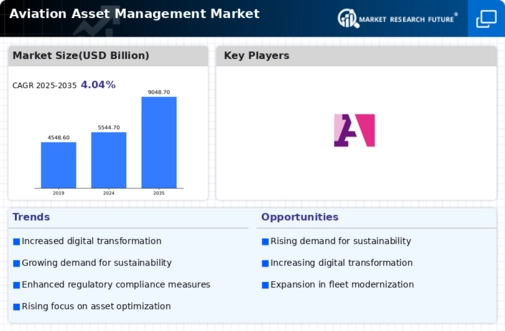Market Growth Projections
The Global Aviation Asset Management Market Industry is poised for substantial growth, with projections indicating a market size of 5544.7 USD Billion in 2024 and an anticipated increase to 9048.7 USD Billion by 2035. This growth trajectory suggests a compound annual growth rate (CAGR) of 4.55% from 2025 to 2035. The increasing complexity of aviation operations, coupled with the demand for efficient asset management solutions, is likely to drive this expansion. As airlines and operators continue to invest in advanced technologies and sustainable practices, the market is expected to evolve, presenting new opportunities for stakeholders.
Regulatory Compliance and Safety Standards
The Global Aviation Asset Management Market Industry is significantly influenced by stringent regulatory compliance and safety standards. Governments and aviation authorities are enforcing regulations that require airlines to maintain high safety and operational standards. This necessitates effective asset management strategies to ensure compliance and mitigate risks. As a result, airlines are increasingly investing in asset management solutions that facilitate adherence to these regulations. The focus on safety and compliance is expected to drive market growth, as operators seek to enhance their asset management capabilities to meet evolving regulatory requirements.
Growing Demand for Efficient Asset Management
The Global Aviation Asset Management Market Industry is experiencing a surge in demand for efficient asset management solutions. Airlines and operators are increasingly recognizing the need to optimize their asset utilization to enhance operational efficiency and reduce costs. This trend is driven by the rising complexity of aviation operations and the need for real-time data analytics. As a result, the market is projected to reach 5544.7 USD Billion in 2024, reflecting a growing emphasis on maximizing the value of aviation assets. Companies are investing in advanced technologies to streamline asset management processes, which is likely to further propel market growth.
Technological Advancements in Asset Management
Technological innovations are playing a pivotal role in shaping the Global Aviation Asset Management Market Industry. The integration of advanced technologies such as artificial intelligence, machine learning, and the Internet of Things is transforming asset management practices. These technologies enable predictive maintenance, real-time monitoring, and data-driven decision-making, which enhance operational efficiency and reduce downtime. As airlines adopt these innovations, the market is expected to witness substantial growth, with projections indicating a rise to 9048.7 USD Billion by 2035. The ongoing digital transformation in aviation is likely to create new opportunities for asset management providers.
Increasing Fleet Size and Expansion of Airlines
The expansion of airlines and the increasing fleet size are key drivers of the Global Aviation Asset Management Market Industry. As airlines expand their operations to meet growing passenger demand, they are acquiring new aircraft and enhancing their existing fleets. This growth necessitates robust asset management strategies to optimize fleet performance and ensure efficient resource allocation. The market is projected to grow at a CAGR of 4.55% from 2025 to 2035, driven by the need for effective management of larger and more diverse fleets. Airlines are likely to invest in comprehensive asset management solutions to support their expansion efforts.
Focus on Sustainability and Environmental Impact
Sustainability is becoming a central theme in the Global Aviation Asset Management Market Industry. Airlines are increasingly prioritizing environmental impact and seeking ways to reduce their carbon footprint. This focus on sustainability is driving the adoption of asset management practices that promote fuel efficiency and reduce waste. As regulatory pressures and public awareness of environmental issues grow, airlines are likely to invest in sustainable asset management solutions. This trend is expected to contribute to the overall growth of the market, as operators align their asset management strategies with sustainability goals.





Leave a Comment